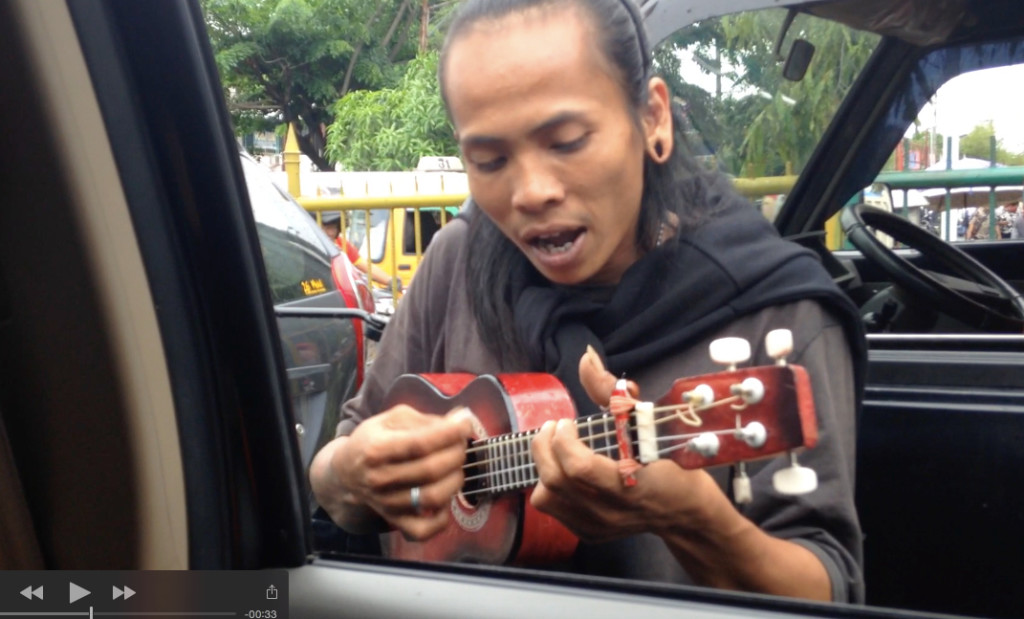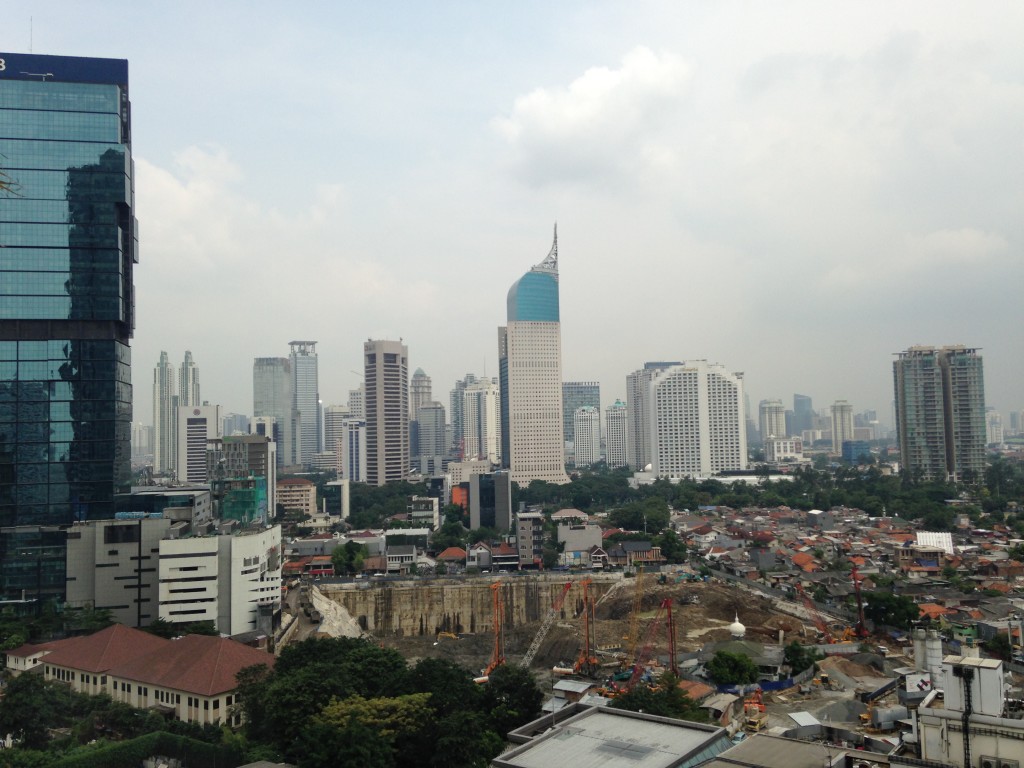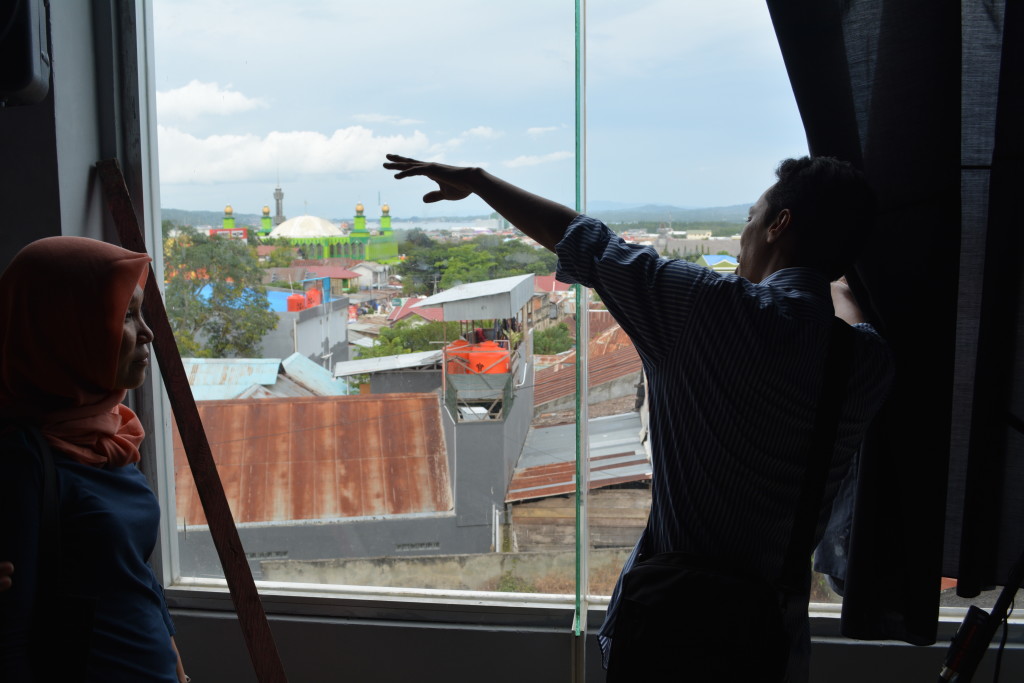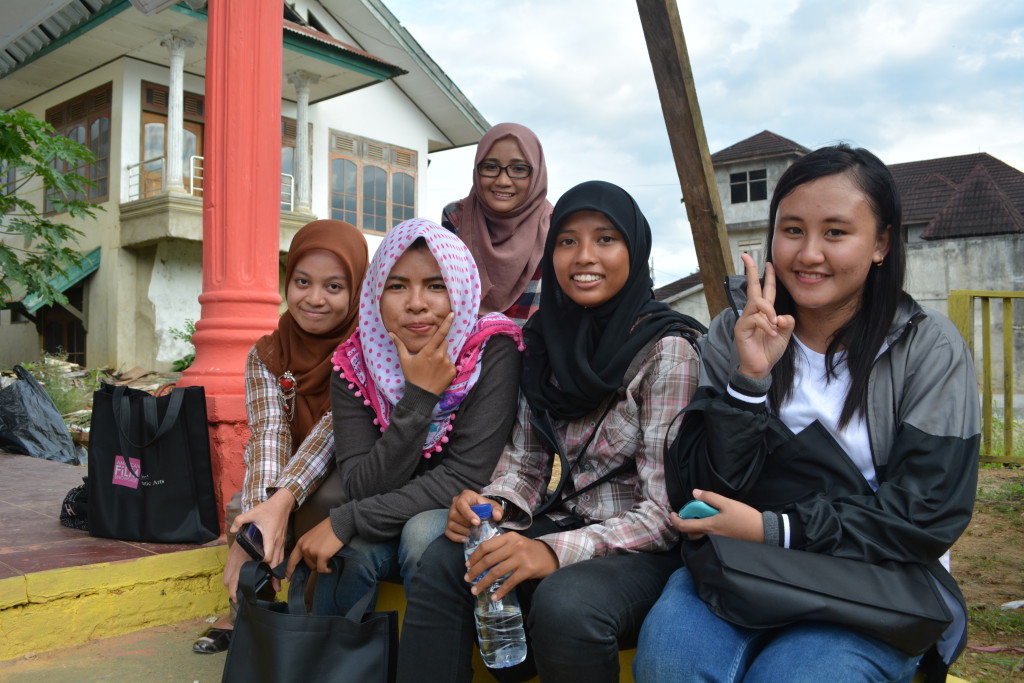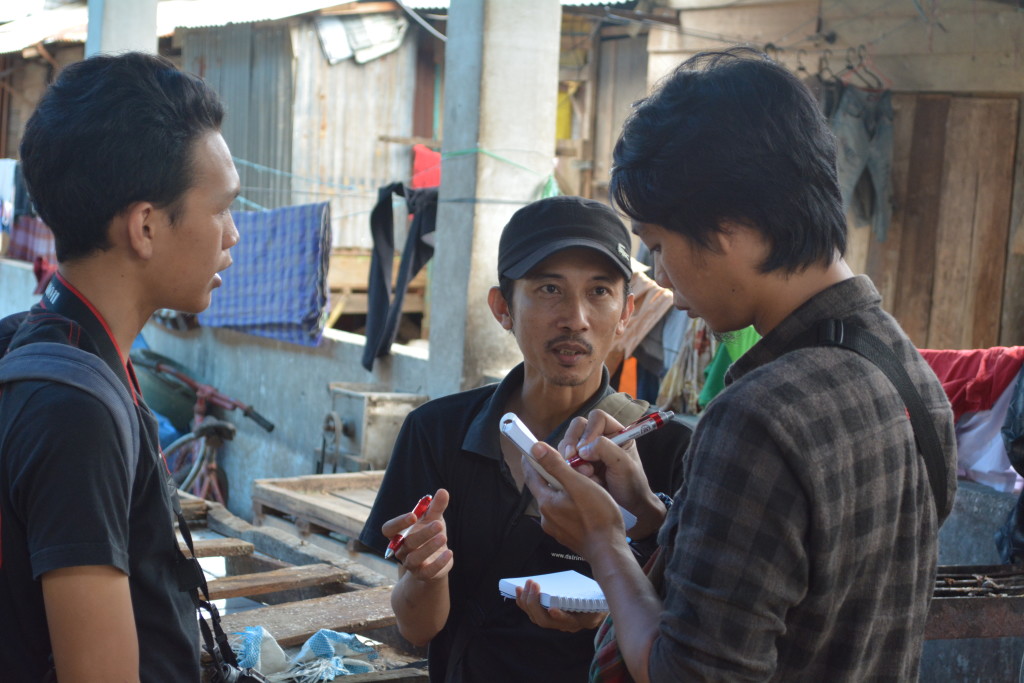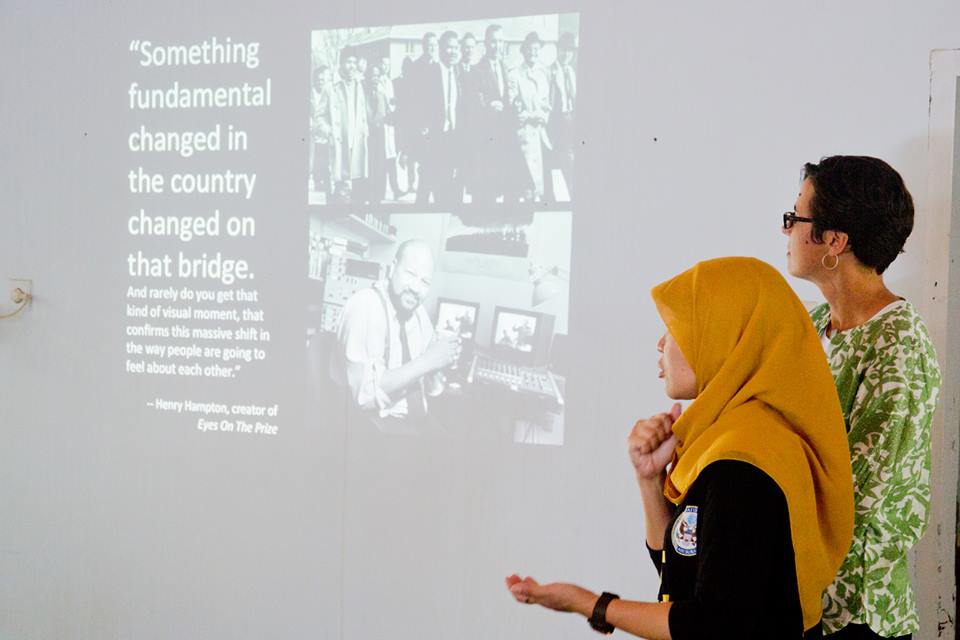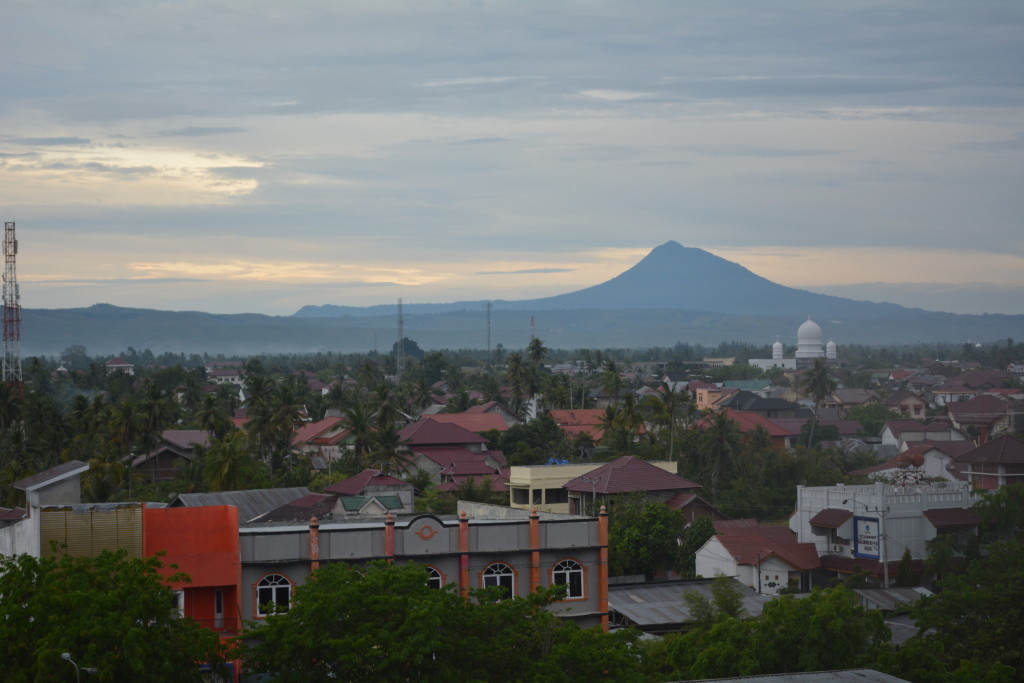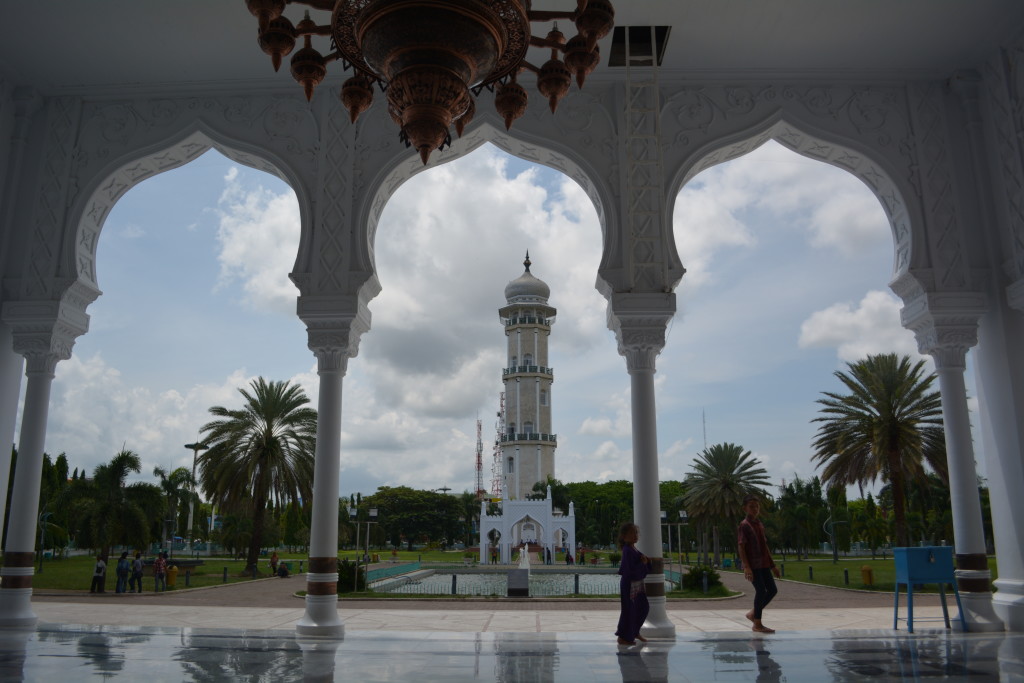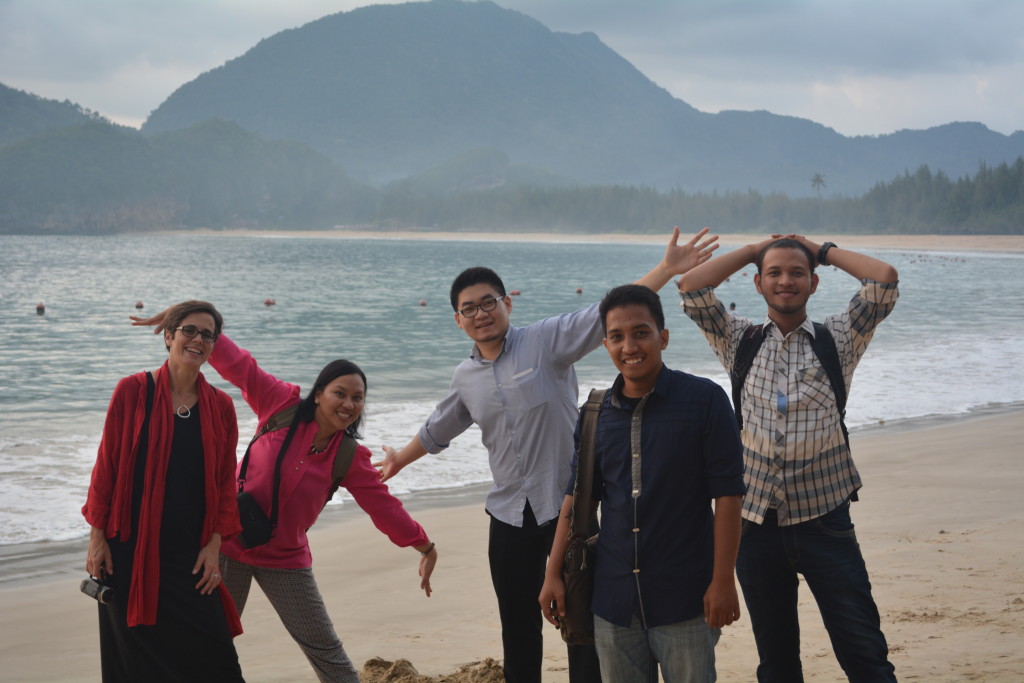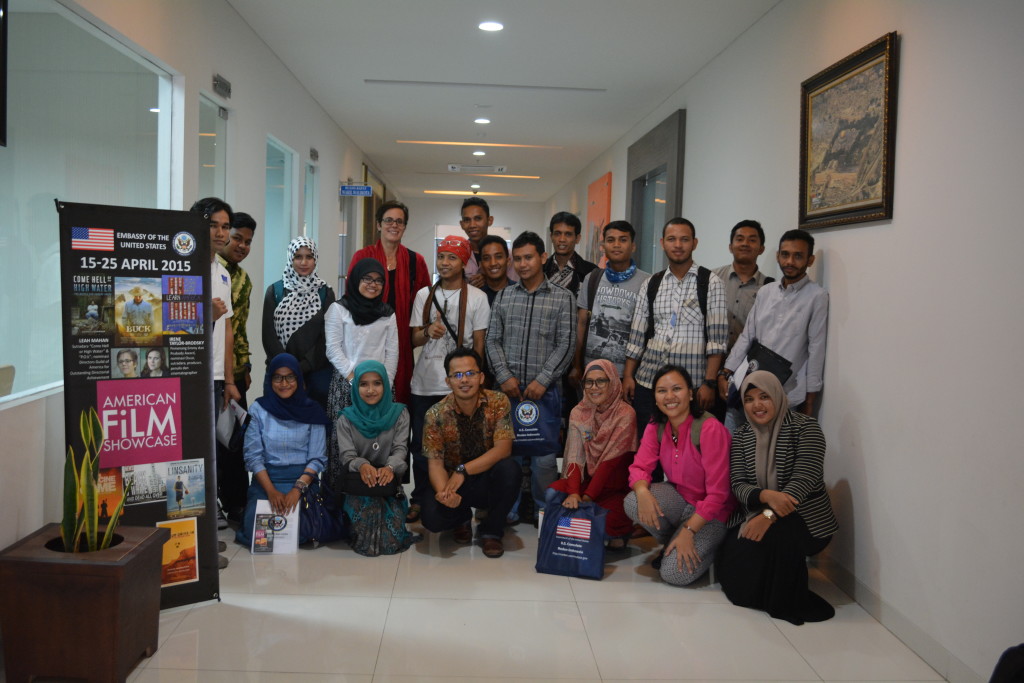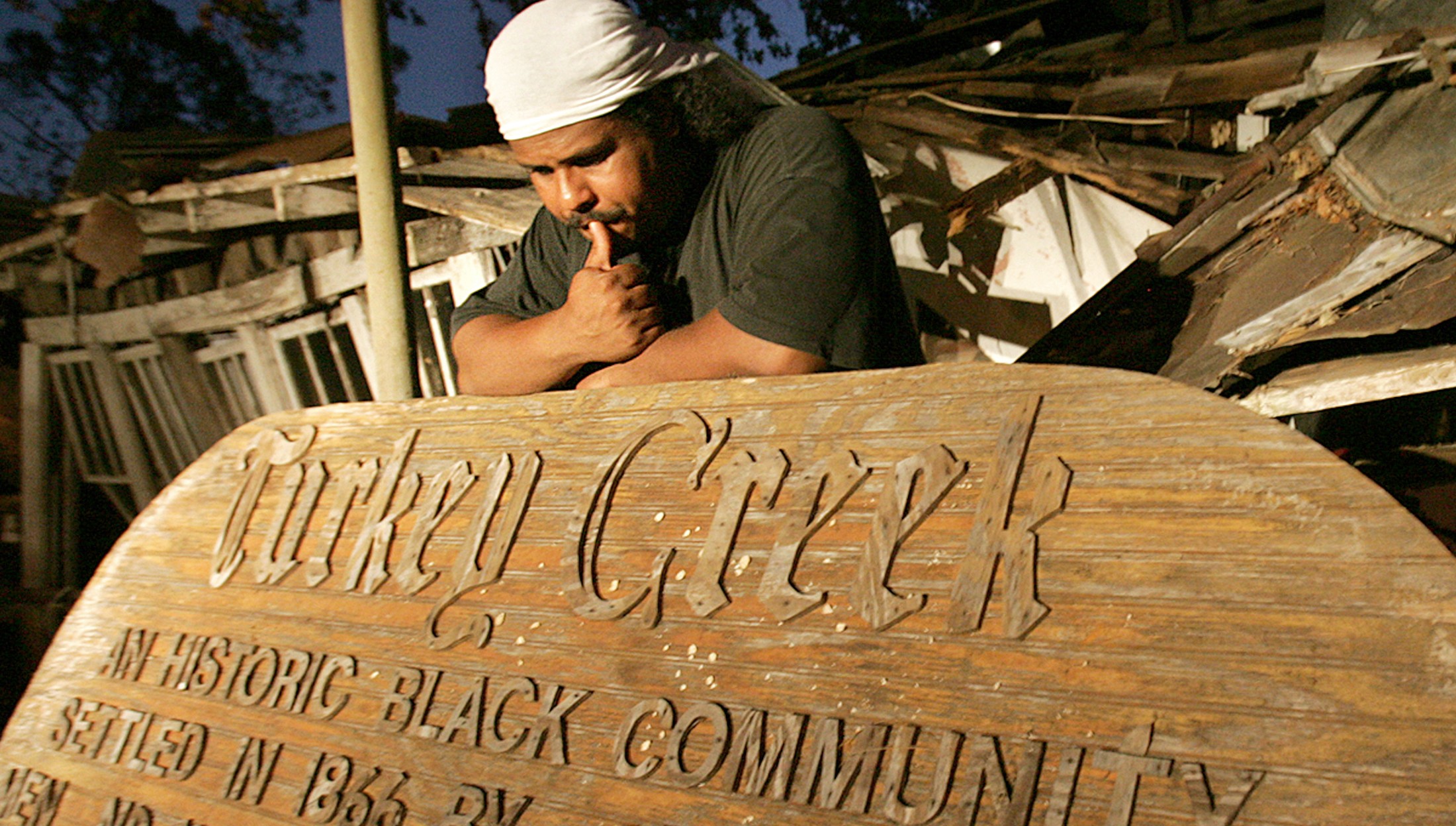In April Leah Mahan traveled to Indonesia as a Film Envoy with the American Film Showcase to share Come Hell or High Water and lead discussions and workshops with students, environmentalists, journalists and filmmakers. Her post on the trip is below and there are a few additional photos here and many more on Flickr and other updates in the newsletter. The trip was covered by the media in Indonesia, including the Jakarta Post and CNN Indonesia.
Among the rush of memories from my eleven days in Indonesia last month, one keeps bobbing to the surface. I was traveling with U.S. embassy staff in Medan, a sprawling city of 7 million in North Sumatra, waiting at a stoplight in the heavy traffic I’d grown accustomed to in large and small cities here. As trucks spewing diesel idled, motorbikes whirred by carrying women in headscarves, men wearing flip flops and an occasional family with a small child tucked in between two parents. A street musician playing a ukulele approached the window of our SUV, singing an upbeat tune. Having once made a documentary about a string-band musician who was sent on a cultural diplomacy tour with the U.S. Department of State, as I was doing now, I felt the urge to record the song on my phone. Everyone, including those in a neighboring truck, got a kick out of my oversized tip of 50,000 Rupiah (less than $4 U.S.). As we pulled away, someone offered to translate the lyrics. It turns out it was a protest song, urging listeners to consider the ways Indonesia, free from colonial rule for six decades, colonizes itself.
Indonesia is a vast, diverse and contradictory place, and the gap between my perception at that moment and the actual message seems a fitting metaphor for my feeble attempts to take it all in, and the hidden gems of discovery I found in my interactions with people.
There are more than 17,000 islands in Indonesia, and my tour with the American Film Showcase touched down on three of the most populated ones: Java, Sulawesi and Sumatra. I understood that the U.S. embassy had good reason to believe that my film about a tiny community in coastal Mississippi would speak to Indonesians, but I wasn’t sure what to expect. Indonesia is the fourth-most populous country and a secular nation with the world’s largest Muslim population and hundreds of ethnic groups. I had read about tensions between rapid development, cultural traditions and ecological conservation. I knew I would be showing the film to students and professionals involved in documentary filmmaking, and to environmental groups and students addressing issues of displacement, deforestation, pollution and the erasure of urban open space.
Filmmaker Irene Taylor Brodsky and I were paired up for this trip, but our program schedules only overlapped briefly in Jakarta at the beginning and end of our visit. We had a lot to talk about when we crossed paths, not only about the people and places we had encountered, but about our Skype visits with our children back home. Irene traveled with the program last year with her film Saving Pelican 895, which follows the fate of a bird oiled by the BP disaster, and was screened on the final night of our tour at the Department of State cultural center in Jakarta.
The program began for both of us at the home of Ambassador Robert Blake, where about 50 people involved with film and environmental issues in Jakarta gathered to watch and discuss my film Come Hell or High Water: The Battle for Turkey Creek. At one point Irene and I were asked to join the Ambassador to speak with a group of local journalists, and I was struck by the fact that the majority were young women – a pattern I would see throughout the trip. Another recurring theme was a question that would come up at just about every screening. People consistently wanted to know what it meant for me to make a film that was critical of government. Was I afraid or did I fear reprisals? Given Indonesia’s history, the question wasn’t surprising.
When preparing for my trip, I had gathered up some books to provide me with reference points beyond those that were jumping out at me – The Act of Killing and headlines about pending executions. One of the books was a worn copy of This Earth of Mankind, by Pramoedya Ananta Toer, who began this first in a series of four novels when he was a political prisoner under the Suharto regime in the 1960s. I sought out his writing because he was described as one of few writers with a coherent vision of his country’s complexity. The series chronicles the struggle for independence against Dutch colonialism, and Pramoedya worked on the books for years without any writing implements, by telling the story to his fellow prisoners. His work was censored in Indonesia, but his ideas fueled the pro-democracy movement that ended Suharto’s three decades in power in 1998. Knowing something about this steadfast advocate for free speech and civil rights gave me some needed perspective on Indonesia’s past.
Over the next ten days I took five domestic flights between locations and my days were filled with screenings and discussions on college campuses, more informal meetings with environmentalists and filmmakers, and a couple radio shows. In addition, I led more intensive workshops with people interested or already engaged in making documentary films. These were rich experiences for me, and I’ll focus on describing those programs, which came at the beginning end of the trip, in Kendari and Banda Aceh.
The day I headed to Kendari, a city in Sulawesi, I met up with the enthusiastic Public Affairs team from the U.S. Consulate’s Surabaya office. They had worked with Yascita, a local NGO, to plan a day-and-a-half-long program on documentary filmmaking for a group of about two dozen participants. Most were college-age, but some were as young as middle school and a few worked at the TV station associated with Yascita. The organization began in 1998 with a focus on protecting Sulawesi’s natural resources, and producing independent radio and television was an outgrowth of its outreach and education work.
Some of the participants had overcome big obstacles just to take part. I heard that one young man traveled on public transportation for five hours to attend, and learned from a video made in the workshop about a young woman’s struggle against her family’s strong opposition to her pursuit of higher education. Another young woman was visibly anxious and excited to gather as much information as she could, and seized a moment during a break to ask questions ranging from creating a documentary budget and script to working on dangerous subjects. A friend helped translate as her questions poured out.
Our goal for the workshop was to explore documentary storytelling and create short character portraits of five minutes or less that focused on someone in the community facing a significant challenge. I began this workshop and others by talking about my first internship working for filmmaker Henry Hampton. I started with a slide with two photos of Henry – one marching in Selma in 1965 and the other producing Eyes on The Prize – with a quote: “Something fundamental changed in the country on that bridge.” I talked about the 50th anniversary of the Bloody Sunday march just a few weeks before, and the role of documentary film in U.S. democracy. I showed clips from my work and talked about principles of nonfiction storytelling, referring to ideas in Sheila Bernard’s book Documentary Storytelling.
When we regrouped in the afternoon, four teams pitched their ideas to the class, then went off to shoot footage they would edit that evening and bring to class the following morning. Oktovianus “Okto” Tonapa, the host of the workshop at Yascita, guided me and the consulate staff around to the shooting locations so I could give input as the participants planned and carried out their shoots. The subjects were diverse, but all dealt with serious issues, from street vendors suffering after a forced move to a market that few visit, to the young woman separated from her children when her family disapproved of her education plans. I was impressed with the projects we watched the next morning and only wish I had more time to talk about sound recording, which was a challenge in most of the shooting locations.
That night, as we headed to a screening, there was a torrential downpour that flooded the street. Someone joked that it was “free advertising” for Come Hell or High Water. Okto worried about the young people who would be getting to the event by motorbike, but eventually the room filled with a mixture of people from the workshop and the local arts and culture community. In the discussion afterward, Okto related the film to local issues, including a historic Chinatown that was recently lost to new development. There were questions about laws in the U.S. that should have prevented the destruction of the Turkey Creek cemetery, and discussion about historic preservation and ecological conservation in Kendari, where illegal logging has polluted the bay.
I knew that deforestation and illegal logging were urgent issues in Indonesia, and it was sobering to learn that the country is now the third largest carbon polluter, having surpassed Brazil in deforestation. The palm oil industry is a major force in all this. Indonesia and Malaysia together produce 90% of the world’s palm oil, which shows up in everything from candy to cosmetics. When I traveled next to Sumatra, I met environmentalists, filmmakers and U.S. consulate staff concerned about the impact of deforestation in the Leuser Ecosystem, a 6.5 million-acre area that is the only place were Sumatra’s endangered orangutans, tigers, elephants and rhinos co-exist. All are watching to see how the newly-elected president Joko Widodo will handle tensions with the provincial government in Aceh, which released a 20-year land use policy that did not mention the ecosystem.
In Banda Aceh, there was a public screening of Come Hell or High Water in the auditorium of the Office of the Mayor and Principal Officer of U.S. Consulate Medan Robert Ewing explained why he felt discussion of the film was relevant in Aceh: “The question I’ve heard on my many trips here is how to balance development — we all agree that Aceh needs development — but how to best balance that with environmental conservation.” He urged viewers to consider “how the power of the community can help and harness environmental protection … and how the community can come together to create action.”
The following day there was a workshop with members of Aceh Documentary Community. After my presentation we watched and discussed two recent short documentaries focusing on the intersection of cultural and conservation issues in particular communities. They were made by young people discovering the art of documentary film with support from seasoned filmmakers. One of these projects specifically addressed land issues in Leuser, where a tribal group that has traditionally farmed in the forest is in conflict with government agencies that say this is illegal in what is now a national forest. Meanwhile, illegal logging by large corporations continues at a frightening pace.
These films taking on difficult subjects were inspiring to see and I left the country feeling that my perspective on environmental issues from my vantage point in the U.S. had been dangerously narrow. I met dozens and dozens of young journalists and filmmakers (I’m afraid the internet is now polluted with hundreds of selfies taken with me) and I know many were encouraged by the story of Turkey Creek and Derrick Evans’ fight to defend his community. I was re-energized by their passion and exuberance for documentary storytelling and saw how powerful this cross-pollination can be. More than anything else, I saw how important it is, not just for Indonesia, but for all of us, that these voices reach a wide audience.


